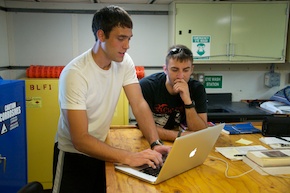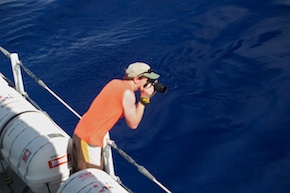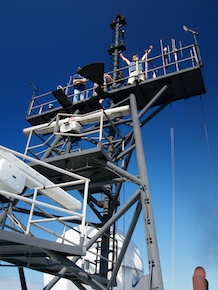The R/V Thomas G. Thompson left Honolulu on November 5, 2011 heading toward the Western Pacific. This expedition journal was written by cruise participants and uploaded about once per weekday, depending on internet availability.
December 7, 2011: Blog within the blog

Writing blogs (Credit: Will Koeppen)
Being a part of something as exciting and intriguing as a geophysics research expedition is something that I’ve never had the privilege to do before. Even if it may not sound that exciting to spend six weeks isolated from everything but science, for me it seems all too short. All of the scientists and engineers on board dedicate 24 hours a day to feverishly collecting, organizing, and interpreting data. Our fearless leaders are busy adapting our course plan to the dynamic obstacles unique to long-term deep ocean research which have included inclement weather and high sea state, pushing technology to its limits, on-site equipment repair. They reassess the situation constantly to make sure that not a single second of this six-week research cruise goes to waste. But while I could go on and on about the epic amount of numbers crunched and the prospective scientific results that we are all fully engaged in finding, I wouldn’t be giving the full picture of what this experience means to the Kutztown University students on board.
If I had a stenographer to stand watch over my daily life, dutifully recording a datapoint every 15 minutes, I might be able to process this experience in situ. If I were the diary writing type, I might be adding entries about my daily life. As it is, the most complete log of our trip may end up being this blog.

New angles (Credit: Nick Mathews)
One of the scientists on this trip, Dr. William Koeppen, is our designated outreach specialist. In essence, he is our stenographer. He ensures that relevant photographs are taken, and designed and maintains this website, which is read all over the country. He and Dr. Adrienne Oakley help us choose topics to write about, edit our writing to crystal clear perfection, and make sure we keep writing. We are driven to meet deadlines to keep the public informed on a nearly day-to-day basis about the happenings on the R/V Thompson.
Why are a daily blog and pictures necessary? First, it is because some of our National Science Foundation research funding is dedicated to exposing more people to some big questions in science today, and how scientists go about finding the answers. A small fraction of the American tax dollar goes into research like this, and like every government-sponsored operation, transparency is a must. Second, any of the Kutztown students will tell you without hesitation that when we are challenged to write either a scientific or nautical-themed blog we end up learning more than we ever expected! We have such an overabundance of intellectual resources here, and there is not enough time in world to absorb all of the accumulated knowledge present on board. At least temporarily, we are one big family, and everyone on board is very helpful no matter who it is or what they happen to be doing. For example, one of our recent blogs, on magnetometers, involved nearly three days of meeting with Dr. Maurice Tivey, and having him explain everything there is to know about magnetism. He was always happy to entertain our inquiries. Of course, since we're on a ship in the middle of the ocean, he literally could not escape our questioning (barring throwing us overboard). Third, this blog lets the landlubbers who are interested in our research, or who have a friend or family member on board, know that we're still alive and having fun.

Out reach (Credit: Will Koeppen)
Having such a wealth of exciting and intelligent shipmates comes at a price, however. When it comes time to officially publish something about a group of professional researchers, every fact about the topic at hand must be reviewed by all whom it may concern. For example, the aforementioned magnetic instrumentation blog went through multiple revisions by several scientists. Three authors were listed, but at least eight people contributed to the final product. Coming from the student blogger’s perspective, it has been a learning process, and having to publish what you just learned in a simple and concise way is much harder than we had imagined. As writers, we have also found that it takes a special sort of attitude to effectively utilize whatever critique or edits are thrown at our work, and not get overwhelmed or discouraged.
While we have a lot yet to learn about the research being done here, there are other lessons as well. After our safe return home, the long trip might get lost in a sea of scattered, hazy memories. When that happens, the focus will already have switched towards objectifying the cruise in terms of scientific results rather than giving it justice as the incredible learning experience that it is for all of us. Looking back, it will be nice to have these accounts depicting all aspects of our experiences. ♦
